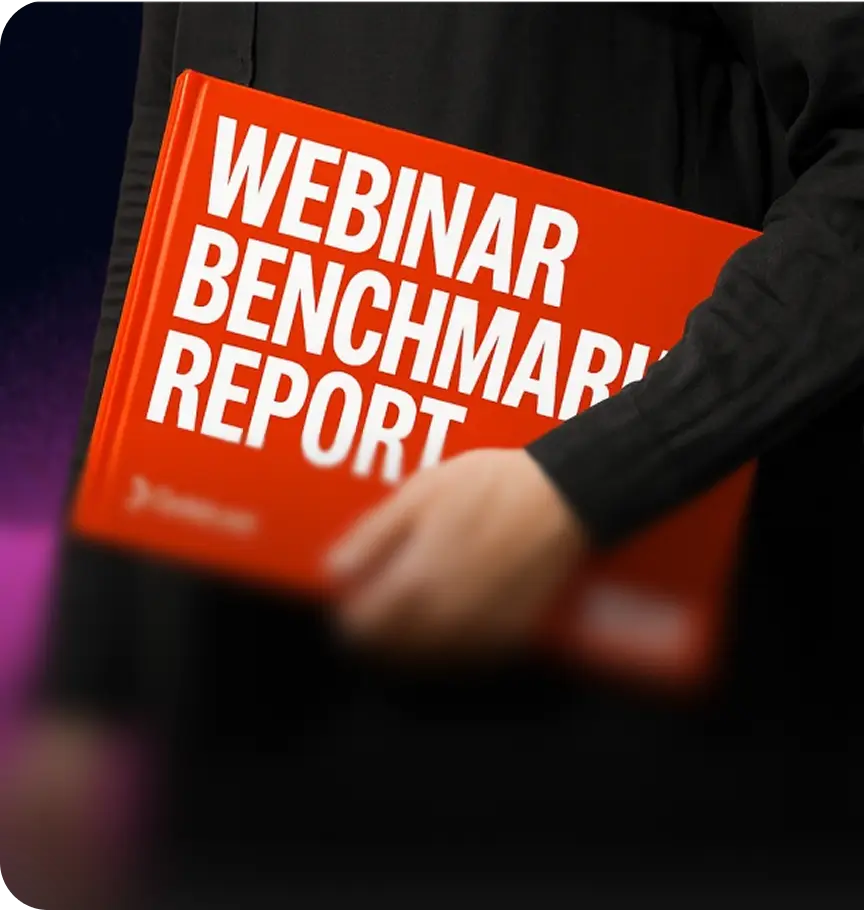7 Tips for Memorable Virtual Product Launch Events

Maximize Your Marketing ROI
Join 10,000 other marketers already getting the best tips on running engaging events that boost pipeline and create raving fans.
A product launch event is an exciting opportunity to unveil your new product and generate momentum around its upcoming release. It allows you to drive product awareness, bolster interest, and spread the word among your network.
And, in the virtual era, product launches can reach even more people than before! Digital product launches marry the benefits of in-person events with the scalability of online marketing, and B2C companies were using them way before virtual events became the norm.
Now it's time for B2B companies to get on board! Today, you'll learn from companies that put on successful digital launch events, see real-world examples that work, and more.
We'll cover:
- Generating product awareness through events: A webinar
- What's a virtual product launch?
- Which companies are good at virtual product launches?
- 7 tips for captivating product launch events
- A note on product launch ROI
- Virtual product launches are a one-way road to product adoption
Let's go!
Generating product awareness through events: A webinar
During our Rock Your Funnel event, Kelly Cheng, Goldcast's Head of Marketing and Growth, spoke with Marcus Andrews, Senior Director of Product Marketing at Pendo, and Julian Sauvage, VP of Corporate and Product Marketing at Clari.
Marcus and Julian shared some of their most memorable experiences with product launch webinars, discussed how to track event ROI, and broke down the different tiers of product launch events.
We've included some of the highlights in this blog post, but check out the full session below! ⤵️
✨ Psst: You can unlock all of our Rock Your Funnel content on-demand now!
What’s a virtual product launch?
First, let's talk more about what a digital product launch entails.
I think a product launch is non-negotiable. You just have to do it." - Julian Sauvage
True to its name, a virtual product launch is a digital event during which the company releases a product to the market. This is a great time to see how folks respond to your product and uncover what questions they have.
Think of it as the pilot episode of a TV show. You are essentially selling your product to a test group of people and gauging the response.
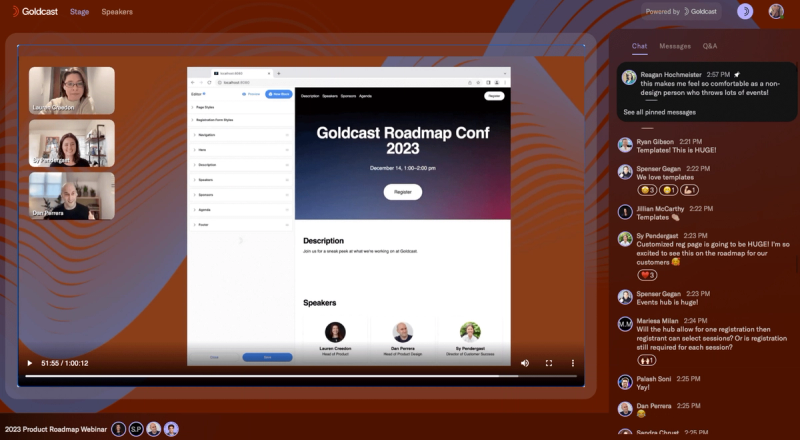
"Events are typically the culmination of a product launch," Marcus explains. "Your launch might start before the event and run after, but the event usually feels like the official date you put on it."
The product launch planning begins with identifying your target audience and creating pre-event buzz. After your launch, you'll generally follow up with people to provide more information or support, or to get feedback.
While the process is quite similar to virtual event planning, there are some subtle differences in the approach.
For instance, you might invite your prospects and customers for a typical webinar. However, for a product launch, you’d invite industry experts, journalists or media, and influencers, along with prospects and customers. Similarly, during virtual product launch promotion, building curiosity among your audience for the product and the event—and not just the event—is crucial.
Which companies are good at virtual product launches?
We've already mentioned that virtual product launches allow companies to truly go global. All you need to pull one off is an event marketing platform and some event promotion chops!
Here are three B2B brands we think have cracked the code of virtual product launches.
1. HubSpot
HubSpot's INBOUND conference is like the Woodstock of digital marketing events, and the company can leverage the event to promote new products and services to attendees. The 2022 INBOUND offering, for example, presented the Age of the Connected Customer.
The focus of this product is to promote a personalized customer experience (CX). To do this, HubSpot released a series of product updates for INBOUND, consistent with the CX approach, and promoted it through the company website, fun videos, and forum posts.
2. Vivun
Vivun is an AI-powered software platform offering a suite of products to improve the buyer experience (BX).
Vivun launched Eval, a collaboration tool for buyers and sellers, through an online event hosted by the company co-founders. The promotions for this launch started with a landing page and were then followed by promotions across various social media channels.
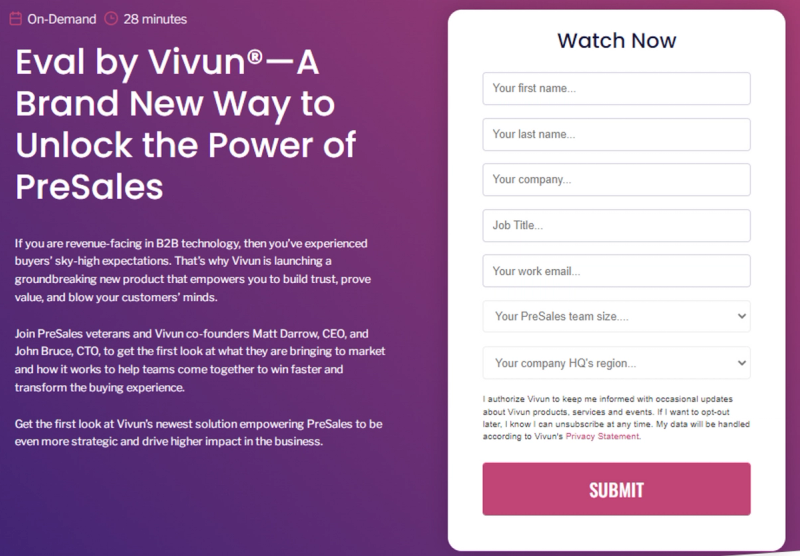
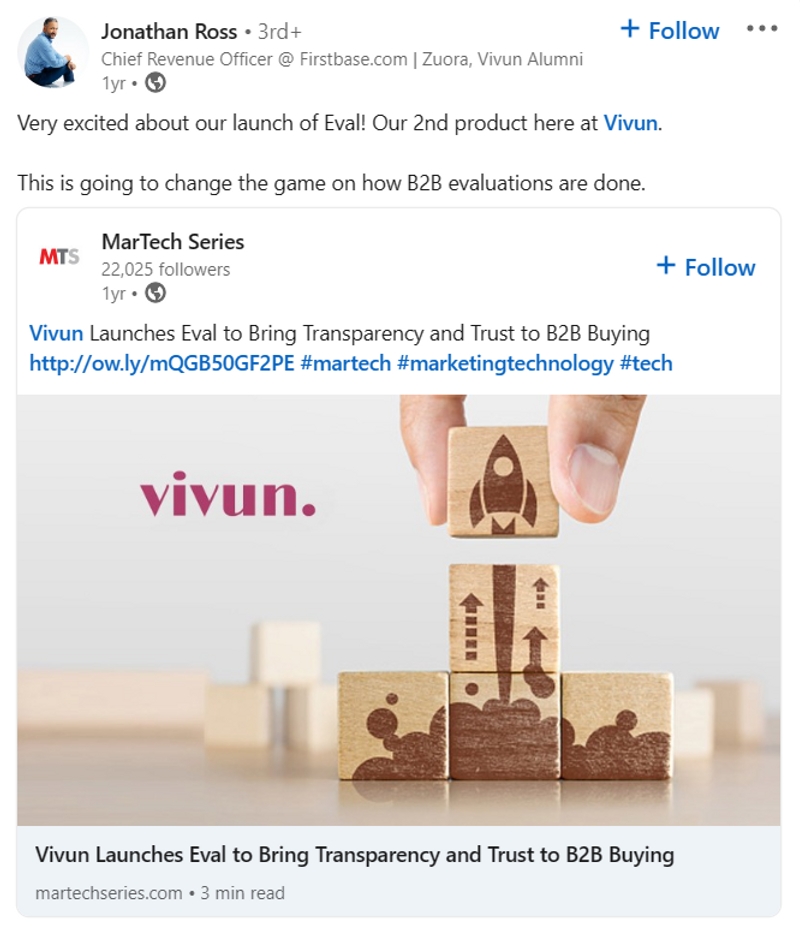
Finally, the post-event follow up saw press releases doing rounds in online publications.
The Eval product launch event is now available on demand and can be viewed by filling out the form on the landing page, which helps Vivun generate marketing qualified leads (MQLs).
As an evergreen buzz builder, Vivun also has a separate landing page that acts as an email list builder for people who want new product announcements.
3. Alyce
The B2B gifting platform Alyce runs a quarterly event titled Alyce Unwrapped, where they discuss new product features, enhancements, and integrations.
The landing page for the event is pretty standard, featuring event info, hosts, and a standard registration form.
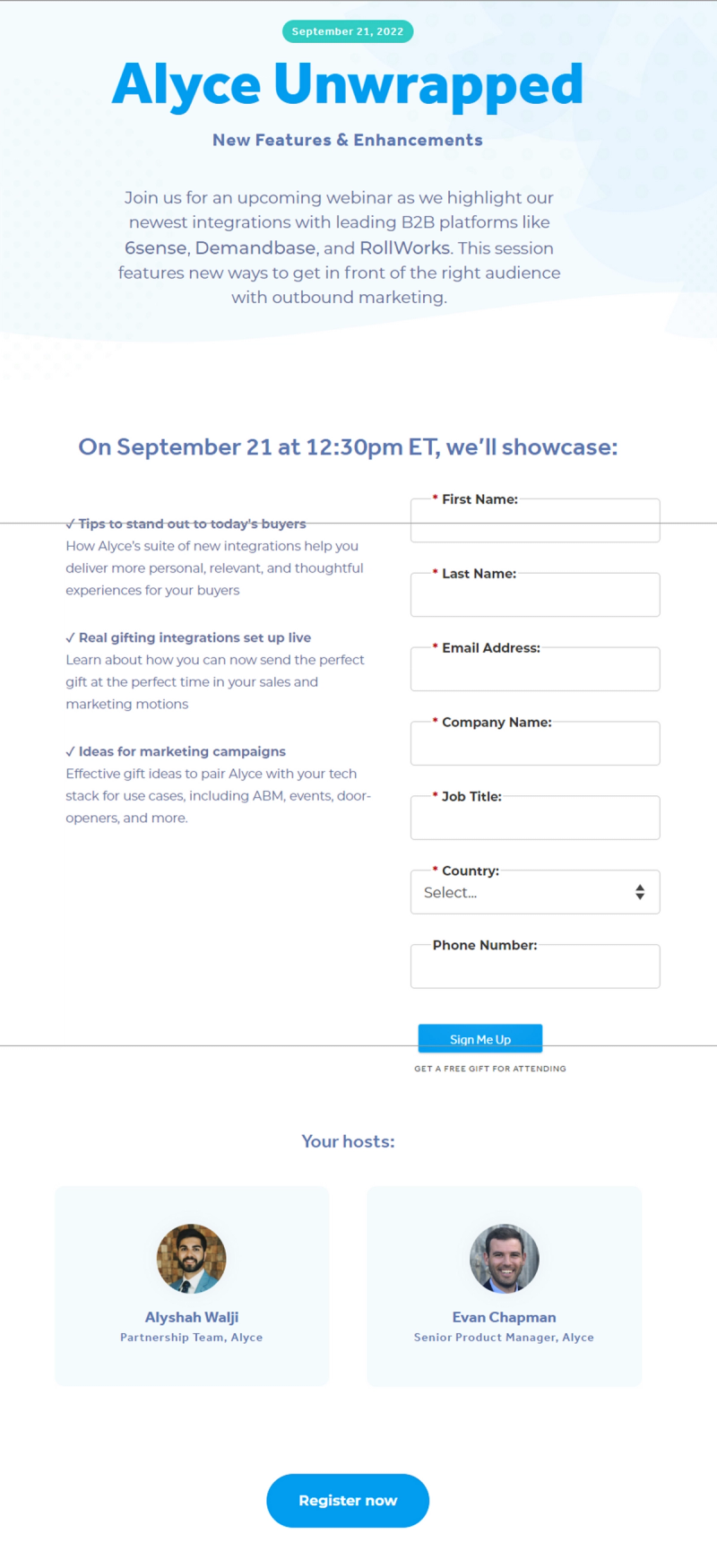
However, an area in which Alyce takes a completely different approach from companies like Vivun is in the event’s on-demand availability. Alyce has ungated Unwrapped so visitors can watch the event recording without filling out a registration form, potentially increasing the number of people who access the content.
7 tips for captivating product launch events
Now that we know what a virtual product launch is and how successful companies execute them, let’s get more in the weeds! This section shares seven tips to plan unforgettable virtual product launch events.
1. Define your event audience
You'll need to know who you want to attend the launch, and your intended core audience depends on what product you're launching. For example, if you're launching a new product feature or integration, you likely want to target existing customers because the goal is to drive feature adoption.
However, if you are launching a brand new product, you'd need to cast a wider net. You want to reach all relevant buyer personas, drive brand awareness, and garner interest. Therefore, you'd likely consider all prospects, customers, subject matter experts, influencers, media folks, and so on.
Once you've identified your audience, figure out why they'd want to attend. This means identifying what challenges your product will solve and developing a narrative that will compel them to sign up. (Check out tip #5 for more on this!)
2. Promote the event
Cutting through the digital noise and getting an audience to care about your event is perhaps the biggest challenge event marketers face.
Your audience is going to determine your promotion plan. If you're inviting existing customers, try email marketing, in-app messaging (pop-ups, push notifications, and chatbot prompts), and 1:1 invitations via your customer success team.
On the other hand, for prospects, you may want to stick to email marketing and 1:1 invites from account sales and biz dev reps.
You can also run LinkedIn ads using contact targeting if you’d like to add one more touchpoint for prospects and customers.
You need to expand into other marketing channels if you want to put on larger events with a big sign-up list. LinkedIn is an obvious place to start for ads. You can also tie up with industry publications and guest blogs on topics tied to your product.
Lastly, don’t ignore the power of small hacks! Use website space like header bars to promote your events. Here’s how we use it at Goldcast to raise awareness of what's coming up:

And, if you are launching something with a partner, like an integration, include the partner in your promotions! Work with them on email and social media campaigns for their target audience; this guarantees you reach more people than you would on your own.
3. Create sales enablement materials
Since customer-facing teams will likely interact with attendees at the launch event, ensure they are well-versed in the new product and features. Organize training sessions for sales, support, and customer success teams to train them on educating, demoing, and selling the product.
You will also need to create internal and external sales enablement materials to help customer-facing teams stay up to speed throughout the launch.
Here’s a brief list of commonly used sales enablement content:
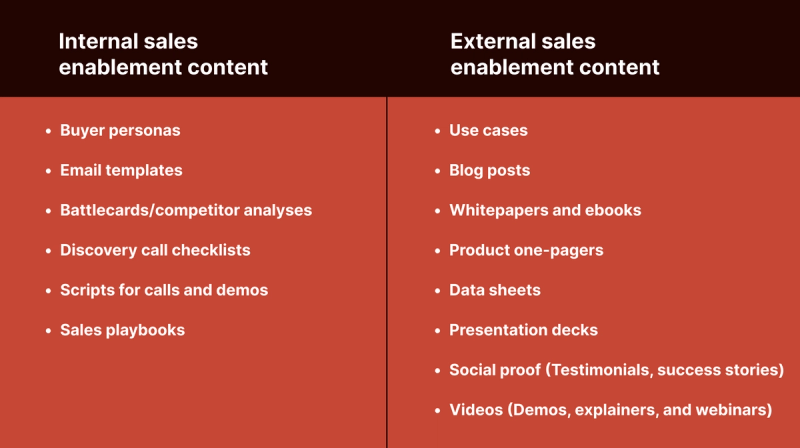
4. Spend time on design
An intentional design will separate your launch event from the hordes of other webinars out there. It’s what gives your event a unique identity and allows you to stay on brand.
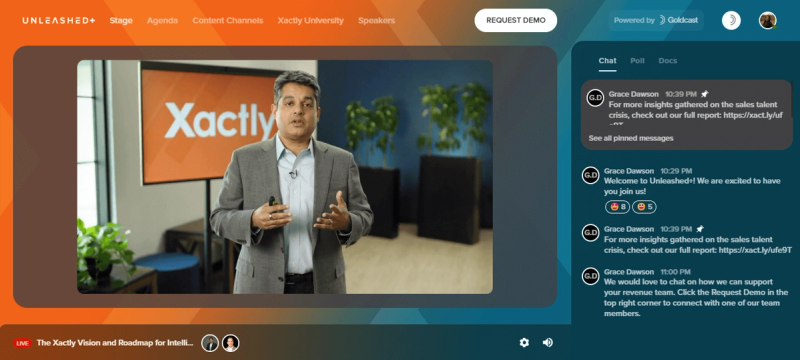
Work with your design team on the event logo, color palette, fonts, typography, illustrations, shapes, and graphic style. These elements should be consistent across every design material, such as the registration page, emails, slide deck, videos, social media posts, stage design, and speaker backgrounds.
🖌️ Working on event design can be a tad overwhelming, but we've got you covered! Check out our blog post on digital event branding to get started.
5. Craft a compelling narrative
Great design combined with a compelling narrative is a recipe for a successful product launch. While the design may grab people's interest initially, it’s the narrative that really motivates them to sign up!
Use storytelling techniques to appeal to your audience's emotions and craft a message that resonates. Tell a story, and tie everything back to your audience's wants and needs. This could be as simple as talking about benefits and sharing customer stories instead of getting into the nitty-gritty of technical details.
Intuit’s "A Giant Story" is a memorable example of how building a narrative can absolutely convey a brand message. The video below depicts how Intuit’s Giant can help businesses grow by offloading taxing paperwork and focusing on work that drives value.
This is a great example of product-led storytelling!
If your product has a beta or soft launch, you can also go with customer-led storytelling. In these instances, instead of focusing on the product, involve customers in the story and let them share their experiences through video testimonials or case studies during the event. You can frame it as the "Hero’s Journey," with your customers as the protagonist and the product driving their inevitable transformation.
6. Amp up the excitement and engagement
So, you’ve done all you can to promote your launch event. Now, how do you keep the energy going on the day of the launch?
Just like a hype person or DJ plays music before the performing act hits the stage, you can do something similar to get the audience pumped up! If you are using Goldcast, you can loop the sizzle reel before the sessions begin. This video can be like a pre-elevator pitch, if there is such a thing.
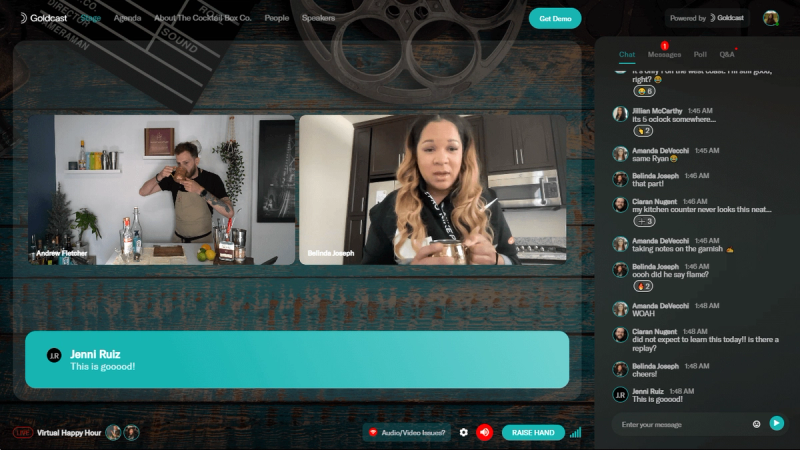
Then, try polls throughout your event to get audience insights and keep them interested. If you're launching an integration that automates data transfer, maybe you ask people how they currently manage the process and share that information with attendees. You can also incentivize engagement through gifts, giveaways, and gamification.
Be sure to save ample time for a Q&A session that lets people interact with you and each other, as well as ask questions.
Don't be afraid to get super creative here! Julian recalls a previous product launch with a limited budget and a "dry topic." His team hired a sketch artist to draw everything that happened during the event, and people loved it!
The final product was almost a mental map of everything that happened between the speakers and the attendees, and they used the sketch as a post-event giveaway, further driving engagement!
7. Plan a thoughtful post-launch follow up
Once your event concludes, keep your audience engaged until your product hits the market—or encourage them to adopt your product if it's already available. As Marcus states, "You have to strike while the iron is hot!"
Once your event concludes, keep your audience engaged until your product hits the market—or encourage them to adopt your product if it's already available!
After your event, customer-facing teams can go full-steam ahead to drive product adoption. At the same time, your sales team will be responsible for following up with any leads and prospects who registered for the event.
We talked about sales enablement content already, but it bears repeating: Make sure your sales team has the information they need to have valuable, insightful conversations with different potential buyers!
For folks who decide to buy your product, develop an onboarding sequence to drive growth. You can do this through post-sign-up email sequences, in-app messaging, and product walkthroughs designed to answer common questions.
Julian follows the 1/1/1 rule: You have one hour after the event to send out a follow-up email, one day for your sales team to reach out, and then one week to offer the customer access to your product in some way.
Finally, don't forget about your content folks; they can use this time to turn your launch event into bite-sized, shareable pieces of content!
A note on product launch ROI
Metrics are always critical, so how do you know what KPIs to work toward here?
"My answer is always simple," Julian says. "I think it's revenue. There's an approach that I think is really wrong, which is thinking your PMM work is successful if your decks are being used, or customers are using your product more—so product adoption KPIs. Those are incomplete. At the end of it, if you don't influence or touch revenue, then what's the point of doing all this?"
By that, Julian means not just revenue itself but average sales price (ASP), ASP growth, revenue coming in from new segments, money generated from accelerated deal cycles, higher win rates, increased retention, etc. "If you nail your story, you're gonna win more and bigger and faster," he says.
Something else you might want to track is product adoption or usage as a result of a specific event. Marcus explains that at Pendo, the team is sure to include a segment during each event where they guide audience members to log in and actually use the product.
"We just did that for a product that we know is tied to retention, and we saw a 5x increase of people inside the product after the event. If you don't tell people to go in and use your product, they won't do it. You have to make it clear and obvious and help them do it, and it really works."
Virtual product launches are a one-way road to product adoption
As you can see, product launches allow your buyers to learn more about your product and company, ask any questions they have, and learn from other customers.
Planning a virtual launch is far from a single event—there are a lot of things that must happen before, and even after, your digital launch event. We hope these tips—from defining your intended audience to post-launch follow-up—help you along the way!

Transform Your Video Marketing with AI
Stay In Touch
Platform
Resources
© 2025 Copyright Goldcast, Inc. All rights reserved.



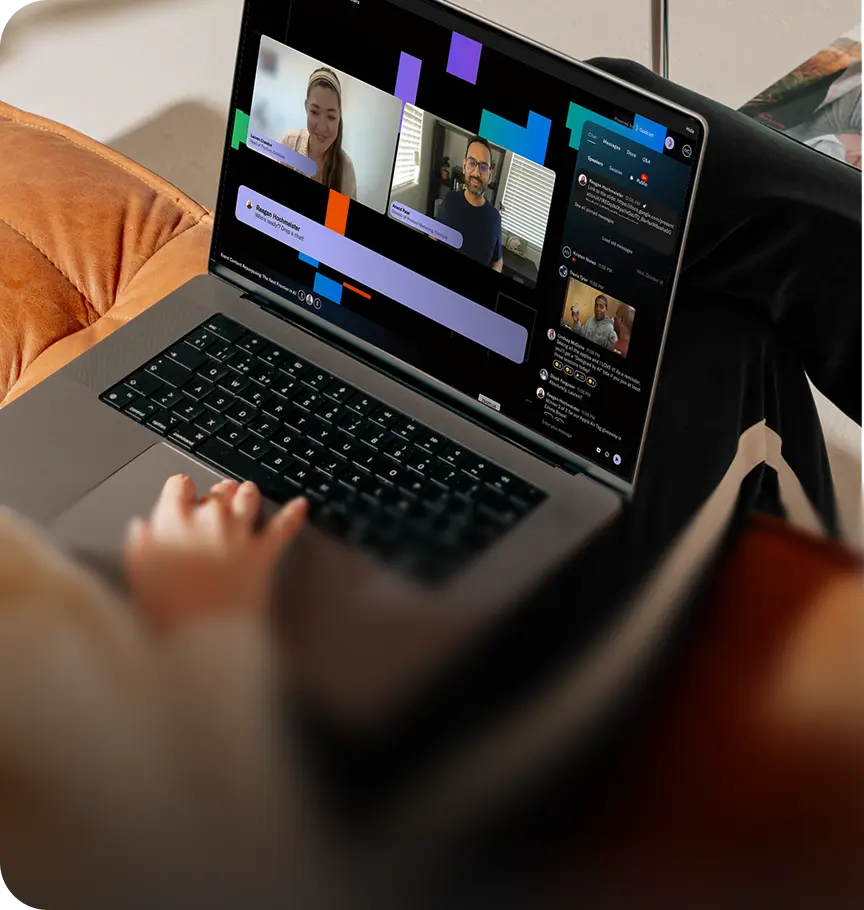

 Upcoming Events
Upcoming Events Event Series
Event Series On-Demand Events
On-Demand Events